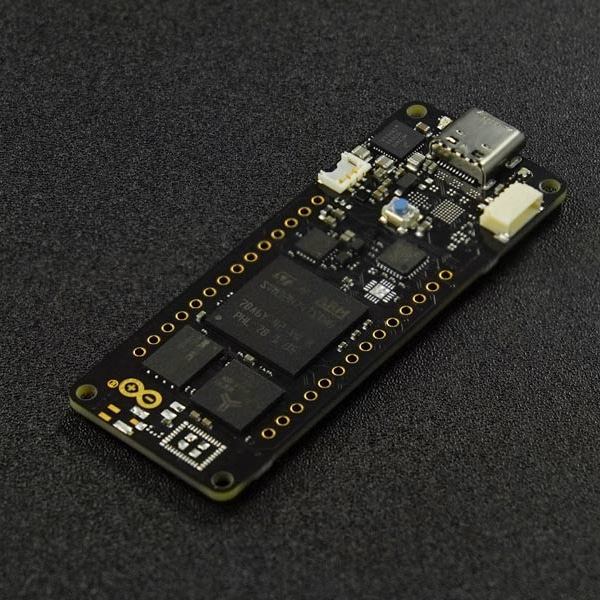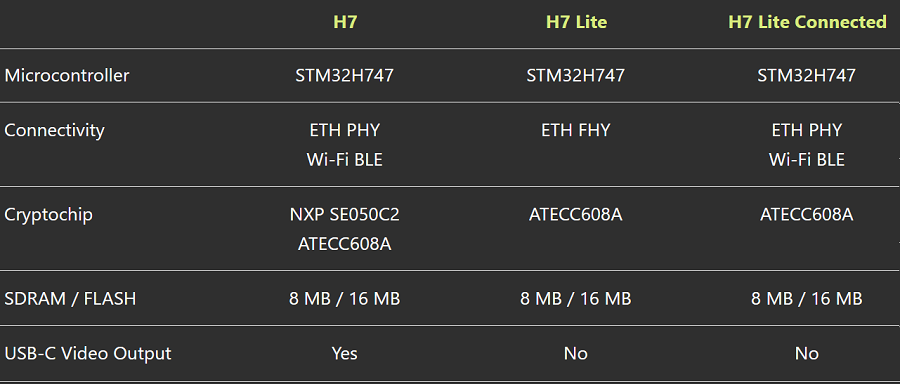아두이노 Portenta H7 Lite 보드
(Arduino Portenta H7 Lite Development Board)

개요
- 본 제품은 아두이노 Portenta H7 Lite 보드입니다.
- STM32H7 MCU 칩을 장착하고 있습니다.
- 16MB QSPI 플래쉬, 8MB SDRAM, USB, 이더넷, CAN 버스 인터페이스를 제공합니다.
특징
- Dual Core - Two best-in-class processors in one, running parallel tasks
- AI on the edge - So powerful it can run AI state machines
- Customization - The board is highly customizable in volumes
- High-level programming language support (Micropython)
- Microcontroller: STM32H747XI dual Cortex®-M7+M4 32bit low power Arm® MCU
- Secure Element (default): Microchip ATECC608
- Board Power Supply (USB/VIN): 5V
- Supported Battery: Li-Po Single Cell, 3.7V, 700mAh Minimum (integrated charger)
- Circuit Operating Voltage: 3.3V
- Current Consumption: 2.95 μA in Standby mode (Backup SRAM OFF, RTC/LSE ON)
- Timers: 22x timers and watchdogs
- UART: 4x ports (2 with flow control)
- Ethernet PHY: 10 / 100 Mbps (through expansion port only)
- SD Card: Interface for SD Card connector (through expansion port only)
- Operational Temperature: -40 °C to +85 °C
- MKR Headers: Use any of the existing industrial MKR shields on it
- High-density Connectors: Two 80 pin connectors will expose all of the board's peripherals to other devices
- Camera Interface: 8-bit, up to 80 MHz
- ADC: 3× ADCs with 16-bit max. resolution (up to 36 channels, up to 3.6 MSPS)
- DAC: 2× 12-bit DAC (1 MHz) available, only one is accessible by the user through the external A6 pin
- USB-C: Host / Device, High / Full Speed, Power delivery
-
Portenta H7 Lite is a high-performance MCU development board and an entry-level product in the Arduino Portenta H7 series. It uses the same STM32H7 MCU chip as the Arduino Portenta H7 but comes with less peripherals to offer a powerful development board at a more affordable price.
The board features a Cortex-M7 core with a clock frequency of up to 480 MHz and a Cortex-M4 core, enabling complex multi-threaded processing and high-speed data handling. It also has 16MB of QSPI Flash memory and 8MB of SDRAM, providing sufficient storage and computing power for most applications.
Despite having fewer peripherals, Portenta H7 Lite still has rich communication interfaces, including USB, Ethernet, and the CAN bus. Moreover, it can be combined with various Arduino MKR expansion boards by its MKR shape to easily and flexibly extend sensors, actuators, and communication interfaces.
Portenta H7 Lite supports multiple operating systems, such as FreeRTOS, Mbed OS, and Zephyr, as well as various development toolchains and libraries, such as Arduino IDE, STM32CubeIDE, and Mbed Studio, providing users with a flexible and diverse development environment.
In summary, Portenta H7 Lite is a powerful and cost-effective development board, suitable for beginners and intermediate developers in various IoT, robotics, and AI application scenarios.
-
What is the difference between Portenta H7, Lite and Lite Connected?
The Portenta H7 is specially designed for high performance in industrial environments. While the hardware is highly customizable, Arduino provide three ready-made solutions:
Portenta H7: The full version. Program using high-level languages and AI while performing low-latency operations on its customizable hardware.
Portenta H7 Lite: A cost-optimized solution, ideal for complex environments where radio communication is not suitable or possible. Designed for developers who want to leverage the same computational power of the Portenta H7, but do not need wireless connectivity, high-resolution video interface, and additional security features.
Portenta H7 Lite Connected: Fills the gap between the full and Lite variants by integrating wireless connectivity, hitting another sweet spot for industrial-strength solutions.

문서
연관제품
- 연관제품 1